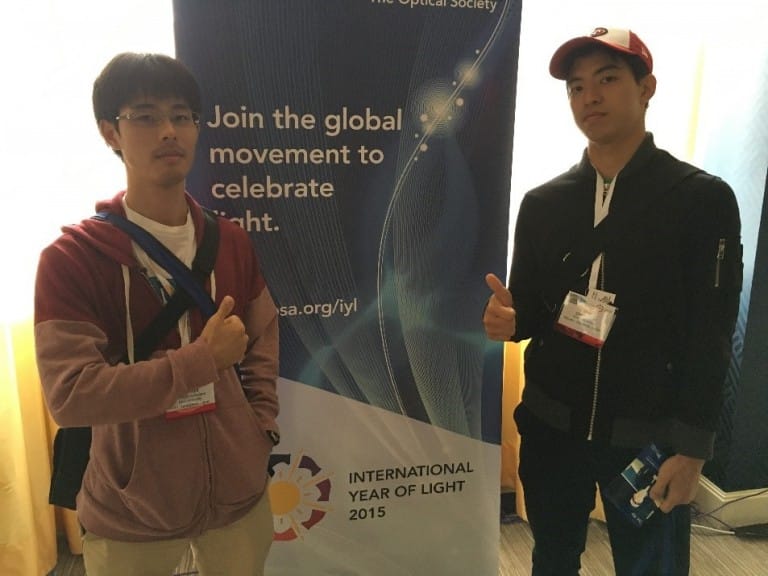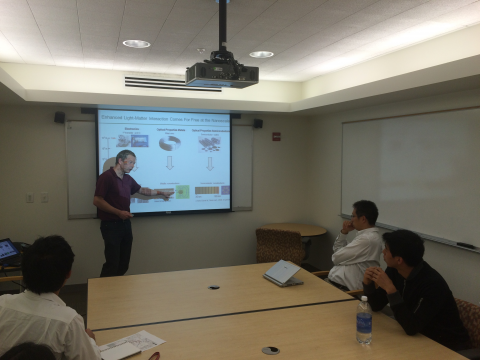OSA (FiO/LS) 2015 Tomoya Kobatake, Sho Tamaki, Yosuke Nakagawa
Research
2015 OSA (FIO/LS) Homecoming Report
M2 Tomoya Kobatake, Sho Tamaki, Yosuke Nakagawa
1. Introduction
The Frontiers in Optics/Optical Society of America meeting was held from October 18 to 22, 2015, in San Jose, California, U.S.A. San Jose is a city located about 90 minutes south of San Francisco by train. It is also famous as Silicon Valley, where Stanford University, which we visited this time, is located, and is a major base for IT companies such as Google, Facebook, and Apple. However, the daily temperatures varied greatly, so one must be careful. Furthermore, I witnessed violent acts on public transportation, which made me feel unsafe.
For the three of us, Frontiers in Optics was the first overseas presentation, and we thought it would be easy to grasp the atmosphere of the contents of the lectures, but we often found it difficult to understand the sessions outside our specialty. However, there were many sessions that I could not understand. However, there were many presentations by groups that have contributed many papers in the same field as Tanabe Laboratory, and I was able to understand the contents well, so it was very meaningful. There were also many invited lectures, and I think it was a very valuable experience to hear lectures by researchers who are active at the forefront of research in the world.
2. Regarding your presentation
JTu4A.45 "Temporal cavity soliton generation without laser scan in a crystalline microcavity with negative TO coefficient."
Tomoya Kobatake, Takumi Kato, Hiroki Itobe, and Takasumi Tanabe
I gave a poster presentation. Since the content of the presentation was quite specialized, the previous knowledge of the audience was not so different from that in Japan. Almost everyone asked me if I had done any experiments and why not, and I realized once again that it is important to demonstrate not only with calculations but also with experiments in order to make it an interesting research. On the other hand, I think it was good that the presentation was easy to explain because I improved the parts that were difficult to convey at the previous applied physics conferences.
JW2A.32 ''Dispersion tailoring of a crystalline whispering gallery mode microcavity for octave-spanning Kerr frequency comb.''
Yosuke NakagawaTakumi, Kato, Yoshiki Wataru, Yuta Mizumoto, Yasuhiro kakinuma and Takasumi Tanabe
I gave a poster presentation in the JW2A/Joint FiO/LS Poster session II on 21st from 9:30 to 11:00 a.m. I expected to see researchers in dispersion and micro optical resonators in OSA (FiO/LS), but it seemed that many non-specialists were interested in these fields. However, it seems that many non-specialists were interested in the presentations. As with Kobatake's comments, there were many questions about experiments, and I felt the need for demonstrations. In the question-and-answer session, I think I managed to understand the questions asked by the participants, but it took time to express my answers in English, and sometimes I was unable to do so, so I need to improve my language skills.
JW2A.11 ''Characterization and fabrication of silica-gold composite toroidal microcavity''
Sho Tamaki, Yoshiki Wataru and Takasumi Tanabe
My presentation was given in the poster session on 10/21 from 9:30~11:00. I presented the results of the calculated nonlinearity enhancement of the resonator when gold nanoparticles were added to silicatroid micro optical resonators, and the results of the optical absorption increase and TO switch when fabricated using the sputtering method. The person presenting next to me also presented results of calculations of optical carcombs in silicatroid micro-optical resonators. The main questions I received during my presentation were as follows.
- Q values are calculated assuming absorption-only effects, but if gold nanoparticles are doped, the mode distribution may change.
- If the sputtering method is used, does the gold exist inside the resonator as particles?
- What are the benefits of doping gold nanoparticles?
- What are the prospects for the future?
Many of the questions were within our expectations, but the point that the distribution of the topmost mode might change was one that we had not considered, and we need to consider it.

3. Presentations by others who were interested
There are methods using surface plasmons to propagate light in a narrow space of less than a wavelength, but these methods have the disadvantage of high optical absorption by metals. In order to solve this problem, a study of a waveguide with a periodic structure made by patterning silicon in units of several 10 nm was presented, and light of 720 nm was successfully propagated with a loss of 2.5 db/100 µm. This research may one day replace plasmon.[FMD.5.] Ultra-narrowband tunable microwave filter created by stimulated Brillouin scattering in a silicon chip
The results of an optical notch filter using induced Brillouin scattering with silicon nanowires were presented. The extinction ratio is 48 dB at 98 MHz, which is very high performance. The wavelength filter can be tuned by controlling the wavelength of the SBS pump light. It was interesting to see how the very simple structure of silicon nanowires can be used.[FTu5C.5.] Molecular Optomechanics with Plasmons: backaction at the nanoscale
There was a background of a large difference between experimental and theoretical values for the intensity of surface-enhanced Raman scattering. The reason for this is that the theoretical calculations do not take into account the optomechanics (vibrations due to resonance) of the localized surface plasmon. We found that the molecular vibration of surface-enhanced Raman scattering can be enhanced by performing bluedetuning to match the vibration of optomechanics. This finding can be taken into account when setting up an actual experimental system to obtain a larger reading of the molecular vibrations.
Ftu2E.2 "Optical Frequency Comb Generators for Trace Gas Sensing" Adam J. Fleisher, David A. Long, Joseph T. Hodges, Kevin O. Douglass, Stephen Maxwell, and David F. Plusquellic
The NIST study is a dual-com gas sensing using an EOM-based optical comb, similar to the one presented at the Japan Society of Applied Physics. The main feature of spectroscopy using this dual comb is the speed of measurement, with detuning switching on the order of 10 μs. The EOM-based comb is easy to use because of its CW excitation and easy frequency tuning, and I felt that the reported applications were quite close to the practical level.
4. Visit to Stanford University
I visited Stanford University for a seminar with Prof. Mark Brongersma, a project participant of the JSPS Core-to-Core Program. Prof. Brongersma's laboratory specializes in plasmonics and semiconductor nanophotonics, and has reported many results in well-known journals such as Nature communications and Nature materials. We were given a tour of their laboratory, and were reminded of the importance of ideas and persistent efforts in research, as the quality of each experimental facility was not significantly different from ours. For example, a metafilm can be composed of Ge wires on an Au film, and the resonance absorption spectrum can be tuned by adjusting the position of the wires (Nature communications 6, 7591 (2015)).


- Categories
- 国際会議報告


